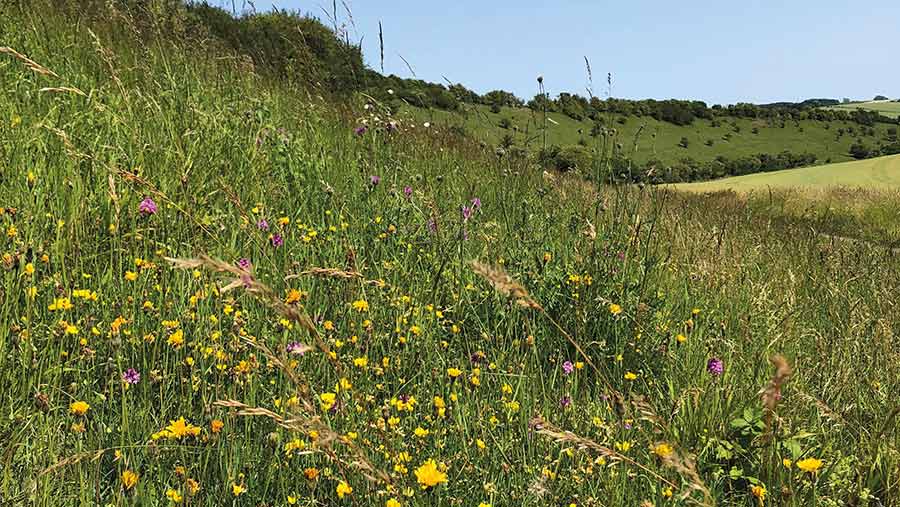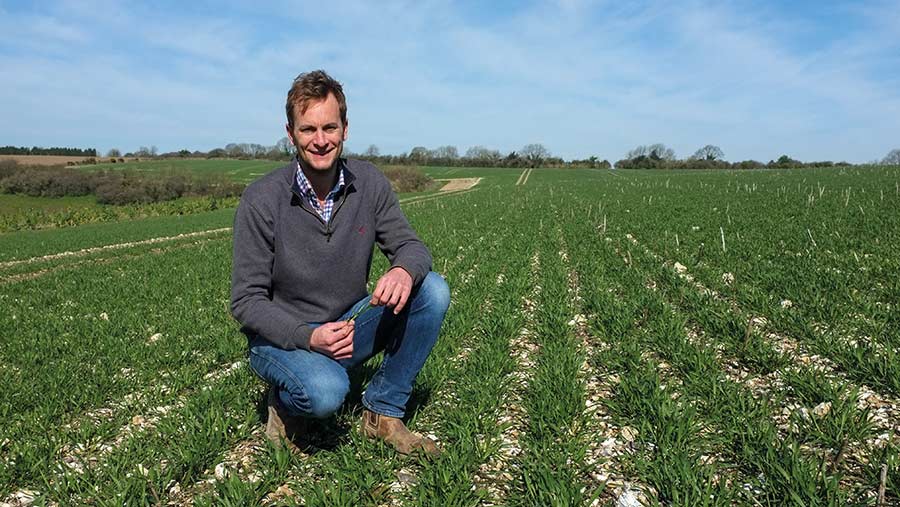Environmental schemes: Should farmers make the switch now?
 © Ben Jeans
© Ben Jeans Buying an outlying 40ha block of arable land just as the Sustainable Farming Incentive (SFI) is being introduced gives Salisbury Monitor Farm host Ben Jeans the opportunity to weigh up the new scheme.
With the first SFI arable soil standards available later this year, offering up to £40/ha for land entered, Mr Jeans is keen to understand whether they are suitable for the new block.
He is also wondering if they would work elsewhere – especially as they can be introduced where existing environmental measures are already in place, to complement rather than duplicate current measures.
See also: How arable growers can qualify for new SFI soil payment scheme
In addition to the arable options, he may find the SFI grasslands soils standard, which is worth up to £58/ha, suitable for the dairy grazing land on his 830ha mixed farming business.
Higher Tier scheme
Already, an existing Higher Tier Countryside Stewardship (CS) scheme, introduced in 2019 at Chalk Pyt Farm, provides £41,000/year.
Its implementation resulted in 27.5ha being taken out of production, with a further 122ha under constrained management and 126ha in downland priority habitat. When in-field stewardship options are counted, they represent 3.6% of productive land.
“Back then, it made sense to move from HLS [Higher Level Stewardship], which at the time could not be extended, into the current scheme – as about one-fifth of the farm is chalk grassland with great species diversity,” says Mr Jeans.

Ben Jeans © AHDB
“With hindsight, we would have put more constrained management options in for our grassland, but the new scheme seemed complex enough.”
As CS still has two more years of life and payment rates have been reviewed, he is wondering whether it is worth putting the new block into CS as well.
Habitat management
“It’s away from our main farm base, so there’s an issue with moving men and machines to do small, habitat management jobs,” he points out. “Although it’s separate from our other land, it won’t be farmed in isolation.”
Otherwise, it is similar to much of the arable land in the area – a big, open landscape on chalk, with some hedgerows and a few other features on it, including an ancient burial site.
As he intends to have spring crops growing for two years in every four, he will be growing cover crops on the block. But no other decisions have been made yet, with Mr Jeans keen to understand more about what can be achieved.
Possible solution
Scale, implementation and placement should be considered when looking at suitable environmental options for arable land, advises Howard Makant, senior land management adviser with Natural England.
That means making any habitat bigger, making it better and then joining it up with other environmental features, he explains, with an aim of having it on 5-10% of the land.
Possible countryside stewardship options for new block |
||||
|
Code |
Option |
Payment rate (£/ha) |
Area (ha) |
Value |
|
AB9/12 |
Wild bird seed |
640 |
1.8 |
1,152 |
|
AB11 |
Cultivated margins |
544 |
0.3 |
163 |
|
AB8 |
Floristic margins |
628 |
1.6 |
1,005 |
|
SW1 |
Grass margins |
419 |
0.4 |
168 |
|
Total |
|
|
4.1 |
2,488 |
“We know we’re going to have to up our game when it comes to factors such as water quality and biodiversity,” he says.
Looking at the new block with CS in mind, the first consideration is where to put any options, says Mr Makant, who points out that they can help to simplify field operations as well as to link up habitats.
Then, the financial considerations come into play, with future private finance options also relevant, he acknowledges. “If hedges are put back, for example, they can become a carbon sink.”
Chosen options
Chalky soils do get rare arable plants, he explains, so the rotational cultivated margins option (AB11) is a good one for the local area.
“They do get a bit ‘weedy’ and are ideal for feeding chicks – if you put them next to a hedge, you also provide refuge for those chicks.”
He also suggests AB8 – floristically enhanced margins – as once they are established, the work involved is completed. Again, putting them along hedges adds to their value.
Countryside stewardship payment rates
Of 133 options in total, the payment rates for 10 have reduced and one (AB13 – brassica fodder crop) has been removed. Nineteen have not changed.
Some 46 have increased by more than £50/ha, including AB1, AB8, GS8, GS3, GS11, SW1, SW3 and SW4.
Among those that have increased by more than 50% are WD4 and organic options.
Otherwise, 4m-wide grass margins (SW1) could be placed along the bottom of the block, to protect water quality, while blocks of wild bird seed (AB9) could be used to square off fields.
Finally, he notes that HS2 could be used around the barrow.
In total, that would take 1.8ha out of production and result in £2,488, or £62/ha.
SFI standards
If Mr Jeans decides to introduce one of the SFI soil standards on the land, he would receive either £22/ha or £40/ha, depending on the level of ambition he opted for.
At the introductory level, he would need to test soil organic matter, produce a soil management plan, ensure that at least 70% of the land entered has a green cover over the winter months and add organic matter to one-third of the land in the standard.
For the intermediate level, he would have to do all of the above actions as well as including multi-species cover crops are in place on 20% of the land entered.
Ben Jeans’ thoughts
While it isn’t exciting financially, the Sustainable Farming Incentive (SFI) does fit well with the farm’s existing system of cover cropping, chopping straw and adding manures, notes Ben Jeans.
That makes the intermediate arable soils standard a no-brainer for the whole farm, including the new block, he remarks.
“The possible inclusion of no-tillage techniques as part of an advanced soil standard from 2023 should also work, as the farm is increasingly going down this route,” he says. “As always, the devil will be in the detail.”
The intermediate grassland soils standard should also be achievable, he believes. “Herbal leys will be new to us, but the 15% target is sensible for this business. Our dairy grazing platform is on droughty greensand, so that would help mitigate this problem.”
The main question with the new block of land is does Countryside Stewardship (CS) make sense there, on top of the SFI, he says.
“It may well do. But it would require options that need minimal management due to its off-lying location – our alternate year hedgetrimming programme would already qualify, for example.
“Of course, there would be benefits from providing habitat for beneficials in an arable-dominant area.”
His final point is that although CS payment rates have been reviewed, over his typical lowland options the percentage increase since his agreement started is well below cost inflation.
“It’s certainly far below the headline 30% figure that has been mentioned.”
Howard Makant and Ben Jeans were speaking at an AHDB-organised Salisbury Monitor Farm meeting, looking at farming environmentally and profitably. The next meeting – an oilseed rape workshop – will be held on 24 February 2022.
